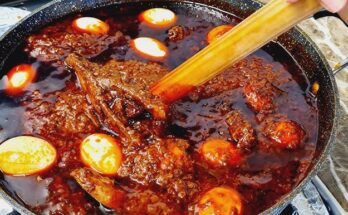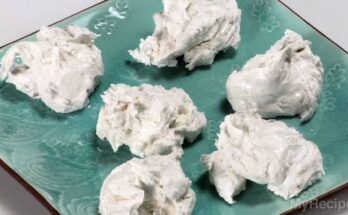Protein Shake Recipe: Let’s face it—life’s busy. And when you’re rushing between meetings, workouts, or family errands, making a wholesome meal from scratch isn’t always possible. That’s where protein shakes step in. These handy blends of nutrients not only save time but also keep you full, energized, and on track with your fitness or health goals. They’re especially popular among athletes, fitness enthusiasts, and anyone looking to boost their daily protein intake without sitting down for a full meal.
Protein shakes are more than just a bodybuilder’s favorite. Today, they’ve evolved into a lifestyle staple, available in hundreds of flavors and formulas. Whether you’re into plant-based diets, keto, or just want something tasty and filling, there’s a protein shake for you. Plus, they can be customized endlessly—from creamy dessert-like shakes to light and refreshing morning smoothies.
Benefits of Adding Protein Shakes to Your Diet
What makes protein shakes such a smart addition to your routine? First off, they’re incredibly efficient. One well-made shake can pack in 20-30 grams of high-quality protein, which helps repair muscles, promote satiety, and even aid in weight management.
Here are some powerful benefits:
- Muscle Recovery and Growth: Ideal post-workout fuel to rebuild muscle fibers.
- Weight Loss Support: Protein keeps you feeling full longer, reducing unnecessary snacking.
- Metabolism Boost: A protein-rich diet helps enhance thermogenesis, which may slightly increase calorie burn.
- Convenient Nutrition: Perfect when you’re short on time but still want a nutritious option.
- Digestive Ease: Many shakes contain fiber or enzymes to support gut health.
Not to mention, shakes can sneak in other nutrients—like antioxidants, fiber, vitamins, and healthy fats—if you toss in the right ingredients.
Choosing the Right Ingredients
Selecting the Best Protein Powder
The heart of your shake is the protein powder, and choosing the right one makes all the difference. Do you go whey, plant-based, casein, or a collagen blend? Here’s how to pick:
- Whey Protein: Fast-digesting and perfect for post-workout recovery. It’s made from milk, so not suitable for vegans.
- Plant-Based Protein: Options like pea, hemp, or brown rice protein are great for vegans or those with dairy sensitivities.
- Casein Protein: Slow-digesting—ideal for nighttime use.
- Collagen Protein: Great for skin, joints, and hair health but lower in complete amino acids.
Look at the ingredient label. Avoid powders with added sugars, artificial flavors, and unpronounceable chemicals. Go for something clean, with at least 20 grams of protein per scoop.
Liquid Bases – What to Use and Why
Your liquid base can make or break your shake. While water works in a pinch, milk or dairy alternatives often make the shake smoother and tastier.
Here are popular liquid options:
- Almond Milk: Low in calories, slightly nutty taste.
- Coconut Milk: Creamy and rich—good for tropical flavors.
- Oat Milk: Smooth texture and slightly sweet.
- Regular Milk (Dairy): High in protein and calcium.
- Water: If you’re watching calories.
Start with about 8-12 oz, depending on how thick you want your shake.
Adding Fruits, Veggies, and Extras for Taste and Nutrition
Now comes the fun part—extras! This is where your shake turns from boring to a nutritional powerhouse.
Fruits:
- Bananas (creamy texture, potassium)
- Berries (antioxidants, fiber)
- Mango (tropical sweetness)
Veggies:
- Spinach or kale (you won’t even taste them!)
- Zucchini (adds volume without flavor)
- Cucumber (refreshing and hydrating)
Other Add-Ins:
- Nut butters (healthy fats and protein)
- Chia or flax seeds (fiber, omega-3s)
- Oats (adds bulk and energy)
- Greek yogurt (extra protein and creaminess)
- Cocoa powder (chocolate flavor without sugar)
Step-by-Step Guide to Making a Protein Shake
Step 1: Gather Your Ingredients
Start by laying out everything you need. Having your ingredients prepped and ready ensures a smooth blending process and a better-tasting shake.
Here’s a basic checklist:
- 1 scoop protein powder
- 1 cup liquid (almond milk, water, etc.)
- ½ banana or ½ cup fruit
- 1 tbsp nut butter or seeds
- Optional: ½ cup veggies, ¼ cup oats, ice cubes
This mix creates a shake that’s tasty, balanced, and packed with about 300-400 calories—great as a meal or heavy snack.
Step 2: Choose the Right Blender
Not all blenders are created equal. A high-powered blender (like a Vitamix or Nutribullet) ensures a silky-smooth texture, especially if you’re adding fibrous greens or frozen fruit.
Look for a blender that:
- Can handle ice and frozen items
- Has at least 600 watts of power
- Is easy to clean
Trust me, the better your blender, the more likely you are to enjoy your shake—no one likes gritty or chunky textures.
Step 3: Add Liquid First
Here’s a trick most people overlook—always add your liquid base to the blender first. This one move can save you a ton of frustration. Why? Because it helps your blades move freely and blend everything evenly, especially if you’re using powders or frozen ingredients.
By pouring the liquid first:
- You reduce clumping.
- You prevent protein powder from sticking to the sides.
- You ensure smoother consistency.
Whether it’s almond milk, oat milk, or plain water, start with about 8 to 12 ounces depending on how thick you like your shake.
If you prefer a milkshake-style texture, go for less liquid and add a few ice cubes. If you like it more drinkable, up the liquid amount just a bit. Play around and see what hits the spot for you.
Step 4: Add Protein and Extras
Now comes the good stuff. Toss in your protein powder next, followed by all the delicious add-ons. Remember, the goal here is balance—taste and nutrition in one blend.
Add your scoop of protein powder on top of the liquid to keep it from clumping. Then follow up with your extras in this order:
- Soft ingredients like bananas or yogurt.
- Fruits and veggies like spinach, berries, or mango.
- Nut butters or seeds for healthy fats.
- Oats or ice cubes last, so they blend more easily.
This layering technique helps everything move toward the blade, giving you a smoother shake.
Want it extra cold? Throw in a handful of ice. Want a creamier texture? Greek yogurt or avocado does wonders.
Don’t be afraid to experiment—protein shakes are like smoothies on steroids. They’re meant to be customized.
Step 5: Blend to Perfection
Hit that blend button and let your machine do its magic. Depending on the ingredients, you’ll want to blend for about 30–60 seconds. Pause and shake the blender if needed (with the lid on, of course!) to help move stubborn ingredients.
Here’s what you’re aiming for:
- No clumps
- No gritty texture
- Smooth, even consistency
Taste test it. Too thick? Add a splash of milk or water. Too thin? Add a few oats, a frozen banana slice, or a spoon of nut butter.
Once you’re happy with the taste and texture, pour it into a glass or to-go cup, pop in a straw, and sip your way to satisfaction.
Tips to Customize Your Protein Shake
For Weight Loss
Trying to shed a few pounds? Protein shakes can be your best friend if you keep them clean and simple. Stick to ingredients that are low in calories but high in nutrition and satiety.
Tips for weight-loss-friendly shakes:
- Use water or unsweetened almond milk.
- Add fiber-rich fruits like berries.
- Use greens like spinach or cucumber to add bulk without calories.
- Avoid high-calorie add-ons like full-fat nut butters—use powdered peanut butter instead.
- Add a touch of cinnamon or vanilla extract for flavor without sugar.
A good weight loss shake clocks in around 200-300 calories and leaves you full for hours.
For Muscle Gain
Looking to build lean muscle? You’ll want your shake to be calorie-dense and packed with high-quality protein and carbs for recovery and growth.
Muscle-building add-ins:
- Whole milk or Greek yogurt for more protein and calories.
- A banana or oats for carbs.
- Peanut butter or almond butter for healthy fats.
- Creatine or BCAAs if you’re supplementing.
Shoot for at least 25-30 grams of protein per shake and aim for around 400-500 calories.
For Energy Boost
Need a morning pick-me-up or a pre-workout power surge? Craft your shake with ingredients that give you clean, sustained energy without the crash.
Energizing shake ideas:
- Add coffee or green tea as your liquid base.
- Toss in oats for slow-releasing carbs.
- Include chia seeds or flaxseeds for brain-boosting omega-3s.
- A bit of honey or dates for natural sugar.
Top it off with a sprinkle of cacao nibs or cocoa powder to satisfy cravings and improve mood.
FAQs about Protein Shake Recipe
Q1: What is the best time to drink a protein shake?
The best time to drink a protein shake depends on your goals. For muscle recovery and growth, it’s ideal to consume it within 30 minutes post-workout. However, it can also be a convenient breakfast or snack anytime during the day.
Q2: Can I make a protein shake without protein powder?
Absolutely! You can use high-protein ingredients like Greek yogurt, milk, cottage cheese, chia seeds, oats, and nut butters to create a nutritious shake without commercial protein powder.
Q3: Are protein shakes good for weight loss?
Yes, when used correctly. A protein shake can be a low-calorie, filling meal replacement that helps control appetite and boost metabolism—supporting your weight loss goals.
Q4: How long do homemade protein shakes last in the fridge?
Homemade protein shakes are best consumed fresh, but they can be stored in an airtight container in the fridge for up to 24 hours. Shake well before drinking as ingredients may separate.
Q5: Can I freeze protein shakes for later?
Yes! Freezing your shake in individual portions is a great way to meal prep. Just thaw in the fridge overnight or blend briefly to restore texture before drinking.
Q6: What are the best add-ins for extra nutrition?
Great additions include spinach, flaxseeds, chia seeds, oats, berries, banana, or avocado. They boost fiber, vitamins, and healthy fats without compromising taste.
Q7: Are protein shakes safe for kids or pregnant women?
Generally, natural, whole-food-based shakes are safe, but always consult a healthcare professional before introducing supplements or changing dietary habits for children or during pregnancy.
Q8: Can I use water instead of milk in my protein shake?
Yes, using water makes the shake lower in calories and suitable for lactose-intolerant individuals. However, using milk adds extra protein, creaminess, and flavor.
Q9: Do protein shakes help build muscle?
Yes. Protein is essential for muscle repair and growth. Regular intake combined with strength training is effective in building lean muscle mass.
Q10: How many protein shakes can I drink per day?
It’s best to limit protein shakes to 1–2 per day, ensuring the rest of your protein comes from whole foods. Overconsumption may strain your kidneys or cause digestive issues.
Final Thoughts and Recommendations
Making your own protein shake is more than just a health habit—it’s a form of self-care. When you control what goes into your shake, you’re taking charge of your nutrition, one scoop and swirl at a time. The best part? You don’t have to be a chef or spend hours in the kitchen. With a few key ingredients and a good blender, you can whip up a nutrient-packed shake in less time than it takes to brew your morning coffee.
Here are a few last pointers to keep in mind:
- Quality Over Quantity: A scoop of premium protein powder and a handful of clean ingredients beats a laundry list of fillers and artificial stuff.
- Keep it Fresh: Always use fresh or frozen fruits and veggies. They taste better and provide more nutrients.
- Prep Ahead: Want to save even more time? Pre-portion your shake ingredients into freezer bags. That way, you just dump and blend.
- Listen to Your Body: Some people thrive on plant protein, others prefer whey. Some love their shakes thick, others thin. Adjust based on how your body feels after drinking it.
Whether you’re using it to recover from workouts, fuel your morning, or replace a meal, your protein shake should be something you look forward to—not a chore to choke down. So mix it up, have fun with flavors, and make each shake work for your goals.



